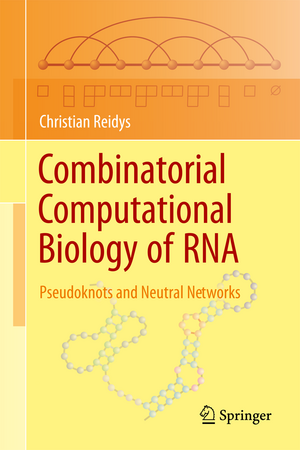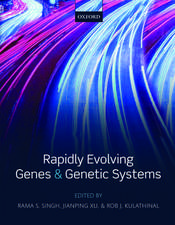Combinatorial Computational Biology of RNA: Pseudoknots and Neutral Networks
Autor Christian Reidysen Limba Engleză Hardback – noi 2010
| Toate formatele și edițiile | Preț | Express |
|---|---|---|
| Paperback (1) | 386.61 lei 6-8 săpt. | |
| Springer – 2 sep 2014 | 386.61 lei 6-8 săpt. | |
| Hardback (1) | 391.61 lei 6-8 săpt. | |
| Springer – noi 2010 | 391.61 lei 6-8 săpt. |
Preț: 391.61 lei
Nou
Puncte Express: 587
Preț estimativ în valută:
74.93€ • 78.08$ • 62.05£
74.93€ • 78.08$ • 62.05£
Carte tipărită la comandă
Livrare economică 03-17 aprilie
Preluare comenzi: 021 569.72.76
Specificații
ISBN-13: 9780387767307
ISBN-10: 0387767304
Pagini: 257
Ilustrații: X, 258 p.
Dimensiuni: 155 x 235 x 20 mm
Greutate: 0.5 kg
Ediția:2011
Editura: Springer
Colecția Springer
Locul publicării:New York, NY, United States
ISBN-10: 0387767304
Pagini: 257
Ilustrații: X, 258 p.
Dimensiuni: 155 x 235 x 20 mm
Greutate: 0.5 kg
Ediția:2011
Editura: Springer
Colecția Springer
Locul publicării:New York, NY, United States
Public țintă
ResearchCuprins
Introduction.- Secondary Structures, Pseudoknot RNA and Beyond.- Folding Sequences into Structures.- Evolution of RNA Sequences.- Methods.- References.- Index.
Recenzii
From the reviews:
“This book is devoted to the study of the structure of combinatorial models of the ribonucleic acid (RNA). … This book can serve as an introduction to the study of combinatorial computational biology as well as a reference of known results and state of the art in this topic.” (Ludovit Niepel, Zentralblatt MATH, Vol. 1207, 2011)
“This book is devoted to the study of the structure of combinatorial models of the ribonucleic acid (RNA). … This book can serve as an introduction to the study of combinatorial computational biology as well as a reference of known results and state of the art in this topic.” (Ludovit Niepel, Zentralblatt MATH, Vol. 1207, 2011)
Textul de pe ultima copertă
In this monograph, new combinatorial and computational approaches in the study of RNA structures are presented which enhance both mathematics and computational biology. It begins with an introductory chapter, which motivates and sets the background of this research. In the following chapter, all the concepts are systematically developed. The reader will find* integration of more than forty research papers covering topics like, RSK-algorithm, reflection principle, singularity analysis and random graph theory* systematic presentation of the theory of pseudo-knotted RNA structures including their generating function, uniform generation as well as central and discrete limit theorems* computational biology of pseudo-knotted RNA structures, including dynamic programming paradigms and a new folding algorithm* analysis of neutral networks of pseudoknotted RNA structures and their random graph theory, including neutral paths, giant components and connectivityAll algorithms presented in the book are implemented in C and are freely available through a link on springer.com. A proofs section at the end contains the necessary technicalities.This book will serve graduate students and researchers in the fields of discrete mathematics, mathematical and computational biology. It is suitable as a textbook for a graduate course in mathematical and computational biology.
Caracteristici
Presents new combinatorics and combinatorial structures and applies them to the study of RNA structures Presents new results on pseudoknot RNA Motivating introductory chapter Includes supplementary material: sn.pub/extras













